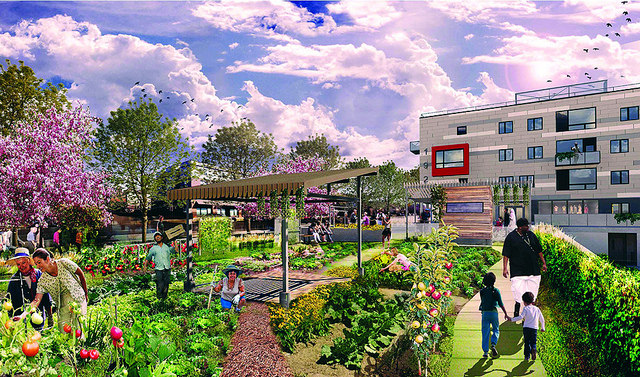When you think of “affordable housing,” what’s the image that comes to mind? For lots of people, including many of those most in need of it, the picture is not a pretty one: it’s a scene of dreary, deteriorating high-rises or shabby, poorly constructed “garden” apartments with no garden in sight.
Moreover, the projects come with lots of safety concerns, placed in “the wrong part of town.” Environmentally, they may be plagued with poor air quality, peeling paint, energy inefficiency, unkempt grounds, and litter.
The Rose is a super-green apartment complex in Minneapolis, Minnesota. I first came across The Rose in an Urban Land Institute email several weeks ago and took notice right way because of a stunning rendering and the project’s ambitious aspiration of achieving recognition under the Living Building Challenge, the most demanding of the green building performance rating programs.
The project comprises 90 apartments in two buildings. Significantly, it does not consist solely of affordable units but, rather, is mixed-income: 47 of the apartments are offered at subsidized rates to qualified residents, and 43 are market-rate; the two categories are indistinguishable with regard to finishes and appearance. Of the subsidized units, seven are set aside for residents who have experienced long-term homelessness; 15 are “section 8” apartments where tenants pay 30 percent of monthly income for rent.
The Rose’s affordable and market-rate homes are interspersed throughout the project, which also includes among its outdoor features a 5,000-square-foot community garden. Additional outdoor amenities for all residents include a courtyard with “a lawn, a play area, a play surface that meets Americans with Disabilities Act standards, a rain garden, a patio with grills, a fire pit, and seating.” Indoor features include a fitness center, a yoga studio, and resident lounges, with floor-to-ceiling glass to maximize light and views. The units all have porches and, in the case of ground-floor apartments, access from the sidewalk as well as from the courtyard.
Green performance of any development is highly related to its location, generally the more central with respect to the metropolitan region the better. The Rose does impressively well on this score, its 2.3-acre site situated in an older, transit-accessible neighborhood just south of downtown Minneapolis. Simply put, people who live there don’t have to drive very much.
Image of The Rose courtesy MSR Design

